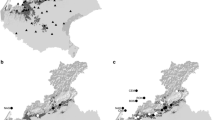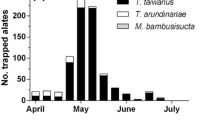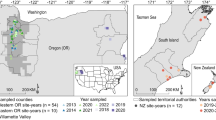Abstract
Modeling the potential spread of Xylella fastidiosa can document contingency plans in northern Europe, so far uncolonized by the bacterium. Through mark–release–recapture (MRR) and flight-mill experiments, the flight capacity of two potential vectors for temperate Europe was studied: Philaenus spumarius, the reported southern European vector, and Aphrophora salicina, a xylem-specialist feeding on potential host plants of X. fastidiosa. Aphrophora salicina displayed significantly better flight performances than P. spumarius. In flight-mills, the average distance flown was, respectively, 623 m vs. 102 m and the maximal distance flown was 6.16 km vs. 1.54 km in 2.5 h. In MRRs, A. salicina travelled more than 30 m in a single flight, with a maximal interception distance of 80 m after two days, highlighting that dispersal is driven by connectivity and host plant quality. Philaenus spumarius mainly jumped, with 1 m movements in length and a maximal interception distance of 32 m in 27 days. Models estimated P. spumarius' daily mean dispersal at 1.5 m and A. salicina's at 3.5 m. Although only a small part of the population moves over very long distances, this pool of efficient insects could already be sufficient to effectively spread an epidemic. As Salicaceae have been reported as host plants of the bacterium, the association of Aphrophoridae and Salicaceae in riparian areas could create bacterium reservoirs in corridors allowing for transportation over medium to long distances.

© 3.18.1 “Zürich.”


© 3.18.1 “Zürich.”


© 4.0.4 (R Core Team, 2021)

© 4.0.4 (R Core Team, 2021)

Similar content being viewed by others
Data availability
Additional data will be provided by the authors upon reasonable request.
References
Almeida RPP (2016) Xylella fastidiosa vector transmission biology. In: Brown JK (ed) Vector-mediated transmission of plant pathogens. American Phytopathological Society Press. Minnesota, USA, pp 165–174
Almeida RPP, Blua MJ, Lopes JRS, Purcell AH (2005) Vector transmission of xylella fastidiosa: applying fundamental knowledge to generate disease management strategies. Ann Entomol Soc Am 98(6):775–786. https://doi.org/10.1603/0013-8746(2005)098[0775:VTOXFA]2.0.CO;2
Anderson-Bergman C (2017) icenReg: regression models for interval censored data in R. J Stat Softw 81(12):1–23. https://doi.org/10.18637/JSS.V081.I12
Attisano A, Murphy JT, Vickers A, Moore PJ (2015) A simple flight mill for the study of tethered flight in insects. JoVE (Journal of Visualized Experiments) 2015(106):e53377. https://doi.org/10.3791/53377
Baumgartner K, Warren JG (2005) Persistence of Xylella fastidiosa in riparian hosts near Northern California vineyards. Plant Dis 89(10):1097–1102. https://doi.org/10.1094/PD-89-1097
Ben Moussa IE, Mazzoni V, Valentini F, Yaseen T, Lorusso D, Speranza S, Digiaro M, Varvaro L, Krugner R, D’Onghia AM (2016) Seasonal fluctuations of sap-feeding insect species infected by Xylella fastidiosa in Apulian olive groves of Southern Italy. J Econ Entomol 109(4):1512–1518. https://doi.org/10.1093/JEE/TOW123
Blackmer JL, Hagler JR, Simmons GS, Cañas LA (2004) Comparative dispersal of Homalodisca coagulata and Homalodisca liturata (Homoptera: Cicadellidae). Environ Entomol 33(1):88–99. https://doi.org/10.1603/0046-225X-33.1.88
Bodino N, Cavalieri V, Dongiovanni C, Plazio E, Saladini MA, Volani S, Simonetto A, Fumarola G, Di Carolo M, Porcelli F, Gilioli G, Bosco D (2019) Phenology, seasonal abundance and stage-structure of spittlebug (Hemiptera: Aphrophoridae) populations in olive groves in Italy. Sci Rep 9(1):1–17
Bodino N, Cavalieri V, Dongiovanni C, Simonetto A, Saladini MA, Plazio E, Gilioli G, Molinatto G, Saponari M, Bosco D (2021) Dispersal of Philaenus spumarius (Hemiptera: Aphrophoridae), a vector of Xylella fastidiosa, in olive grove and meadow agroecosystems. Environ Entomol 50(2):267–279. https://doi.org/10.1093/ee/nvaa140
Cornara D, Saponari M, Zeilinger AR, de Stradis A, Boscia D, Loconsole G, Bosco D, Martelli GP, Almeida RPP, Porcelli F (2016) Spittlebugs as vectors of Xylella fastidiosa in olive orchards in Italy. J Pest Sci 90(2):521–530. https://doi.org/10.1007/S10340-016-0793-0/TABLES/3
Cornara D, Bosco D, Fereres A (2018) Philaenus spumarius: when an old acquaintance becomes a new threat to European agriculture. J Pest Sci 91(3):957–972. https://doi.org/10.1007/s10340-018-0966-0
Costello MJ, Steinmaus SJ, Boisseranc CJ (2017) Environmental variables influencing the incidence of Pierce’s disease. Aust J Grape Wine Res 23(2):287–295. https://doi.org/10.1111/ajgw.12262
Coviella C, Jeske DR, Redak RA (2006) Feasibility of tracking within-field movements of Homalodisca coagulata (Hemiptera: Cicadellidae) and estimating its densities using fluorescent dusts in mark-releas. Artic J Econ Entomol 99(4):1051–1057. https://doi.org/10.1603/0022-0493-99.4.1051
Cox DR (1972) Regression models and life-tables. J Roy Stat Soc Ser B (Methodol) 34(2):187–202. https://doi.org/10.1111/J.2517-6161.1972.TB00899.X
Cruaud A, Gonzalez AA, Godefroid M, Nidelet S, Streito JC, Thuillier JM, Rossi JP, Santoni S, Rasplus JY (2018) Using insects to detect, monitor and predict the distribution of Xylella fastidiosa: a case study in Corsica. Sci Rep 8(1):1–13. https://doi.org/10.1038/s41598-018-33957-z
David G, Giffard B, Piou D, Jactel H (2014) Dispersal capacity of Monochamus galloprovincialis, the European vector of the pine wood nematode, on flight mills. J Appl Entomol 138(8):566–576. https://doi.org/10.1111/jen.12110
Denancé N, Legendre B, Briand M, Olivier V, de Boisseson C, Poliakoff F, Jacques MA (2017) Several subspecies and sequence types are associated with the emergence of Xylella fastidiosa in natural settings in France. Plant Pathol 66(7):1054–1064. https://doi.org/10.1111/ppa.12695
Dupas, E, Durand, K, Rieux, A, Briand, M, Pruvost, O, Cunty, A, Denancé, N, Donnadieu, C, Legendre, B, Lopez-Roques, C, Cesbron, S, Ravigné, V, Jacques, MA (2022) Two bridgehead invasions of Xylella fastidiosa subsp. multiplex in France. BioRxiv, 2022.02.11.480026. https://doi.org/10.1101/2022.02.11.480026
Edwards JS (2006) The central nervous control of insect flight. J Exp Biol 209(22):4411–4413. https://doi.org/10.1242/JEB.02592
EFSA (European Food Safety Authority) (2013) Statement of EFSA on host plants entry and spread pathways and risk reduction options for Xylella fastidiosa Wells et al. EFSA J 11(11). https://doi.org/10.2903/j.efsa.2013.3468
EFSA Plh Panel (EFSA Panel on Plant Health) (2015) Scientific Opinion on the risks to plant health posed by Xylella fastidiosa in the EU territory, with the identification and evaluation of risk reduction options. EFSA Journal 13(1):3989. https://doi.org/10.2903/j.efsa.2015.3989
EFSA Plh Panel (EFSA Panel on Plant Health) (2018) Updated pest categorisation of Xylella fastidiosa. EFSA J. https://doi.org/10.2903/j.efsa.2018.5357
EFSA PLH Panel (EFSA Panel on Plant Health) (2019b) Effectiveness of in planta control measures for Xylella fastidiosa. EFSA J 17(5):e05666. https://doi.org/10.2903/J.EFSA.2019a.5666
EFSA PLH Panel (EFSA Panel on Plant Health) (2019c) Pest categorisation of non-EU Cicadomorpha vectors of Xylella spp. EFSA J 17(6):e05736. https://doi.org/10.2903/J.EFSA.2019b.5736
EFSA PLH Panel (EFSA Panel on Plant Health) (2019a) Update of the Scientific Opinion on the risks to plant health posed by Xylella fastidiosa in the EU territory. EFSA J. https://doi.org/10.2903/j.efsa.2019a.5665
Elbeaino T, Valentini F, Kubaa RA, Moubarak P, Digiaro M (2014) Multilocus sequence typing of Xylella fastidiosa isolated from olive affected by “olive quick decline syndrome” in Italy. Phytopathol Mediter 53(3):533–542. https://doi.org/10.14601/Phytopathol_Mediterr-15000
Erber J (1975) The dynamics of learning in the honey bee (Apis mellifica carnica)* ** II. Principles of information processing. J Comp Physiol 99:243–255
Franklin AJ, Grégoire JC (1999) Flight behaviour of Ips typographus L. (Col., Scolytidae) in an environment without pheromones. Ann For Sci 56(7):591–598. https://doi.org/10.1051/forest:19990706
Franklin AJ, Debruyne C, Grégoire JC (2000) Recapture of Ips typographus L. (Col., Scolytidae) with attractants of low release rates: localized dispersion and environmental influences. Agric For Entomol 2(4):259–270. https://doi.org/10.1046/j.1461-9563.2000.00075.x
Halkka, O, Raatikainen, M, Vasarainen, A, Heinonen, L (1967) Ecology and ecological genetics of Philaenus spumarius (L.) (Homoptera). Annales Zoologici Fennici, 4.
Hasbroucq, S, Casarin, N, Czwienczek, E, Bragard, C, Grégoire, JC (2020). Distribution, adult phenology and life history traits of potential insect vectors of Xylella fastidiosa in Belgium. Belgian J Entomol, 92, 1–21. www.srbe-kbve.be
Hothorn T, Bretz F, Westfall P (2008) Simultaneous inference in general parametric models. Biom J 50(3):346–363. https://doi.org/10.1002/BIMJ.200810425
Krugner R, Backus EA (2014) Plant water stress effects on stylet probing behaviors of Homalodisca vitripennis (Hemiptera: Cicadellidae) associated with acquisition and inoculation of the bacterium Xylella fastidiosa. J Econ Entomol 107(1):66–74. https://doi.org/10.1603/EC13219
Lago C, Garzo E, Moreno A, Barrios L, Martí-Campoy A, Rodríguez-Ballester F, Fereres A (2021a) Flight performance and the factors affecting the flight behaviour of Philaenus spumarius the main vector of Xylella fastidiosa in Europe. Sci Rep 11(1):1–14. https://doi.org/10.1038/s41598-021-96904-5
Lago C, Morente M, De las Heras-Bravo D, Martí-Campoy A, Rodríguez-Ballester F, Plaza M, Moreno A, Fereres A (2021) Dispersal of Neophilaenus campestris, a vector of Xylella fastidiosa, from olive groves to over-summering hosts. J Appl Entomol 145(7):648–659. https://doi.org/10.1111/jen.12888
Landa BB, Castillo AI, Giampetruzzi A, Kahn A, Román-Écija M, Velasco-Amo MP, Navas-Cortés JA, Marco-Noales E, Barbé S, Moralejo E, Coletta-Filho HD, Saldarelli P, Saponari M, Almeida RPP (2020) Emergence of a plant pathogen in europe associated with multiple intercontinental introductions. Appl Environ Microbiol 86(3):01521–19. https://doi.org/10.1128/AEM.01521
López-Mercadal J, Delgado S, Mercadal P, Seguí G, Busquets A, Gomila M, Lester K, Kenyon DM, Pérez R, Paredes-Esquivel C, Miranda MA (2021) Collection of data and information in Balearic Islands on biology of vectors and potential vectors of Xylella fastidiosa (GP/EFSA/ALPHA/017/01). EFSA Supporting Publ 18(10):6925E. https://doi.org/10.2903/sp.efsa.2021.EN-6925
Maes S, Massart X, Grégoire JC, De Clercq P (2014) Dispersal potential of native and exotic predatory ladybirds as measured by a computer-monitored flight mill. Biocontrol 59(4):415–425. https://doi.org/10.1007/s10526-014-9576-9
Meurisse N, Couillien D, Grégoire JC (2008) Kairomone traps: A tool for monitoring the invasive spruce bark beetle Dendroctonus micans (Coleoptera: Scolytinae) and its specific predator, Rhizophagus grandis (Coleoptera: Monotomidae). J Appl Ecol 45(2):537–548. https://doi.org/10.1111/j.1365-2664.2007.01423.x
Morente M, Cornara D, Plaza M, Durán JM, Capiscol C, Trillo R, Ruiz M, Ruz C, Sanjuan S, Pereira JA, Moreno A, Fereres A (2018) Distribution and relative abundance of insect vectors of Xylella fastidiosa in olive groves of the Iberian Peninsula. Insects 9(4):175. https://doi.org/10.3390/INSECTS9040175
Nickel H, Remane R (2002) Check list of the planthoppers and leafhoppers of Germany, with notes on food plants, diet width, life cycles, geographic range and conservation status (Hemiptera, Fulgoromorpha and Cicadomorpha). Beiträge Zur Zikadenkunde 5:27–64
Nilakhe S, Buainain C (1977) Observations on movement of spittlebug adults. Pesq Agrop Brasileira 23(2):123–134
Northfield TD, Mizell RF, Paini DR, Andersen PC, Brodbeck BV, Riddle TC, Hunter WB (2009) Dispersal, Patch Leaving, and Distribution of Homalodisca vitripennis (Hemiptera: Cicadellidae). Environ Entomol 38(1):183–191. https://doi.org/10.1603/022.038.0123
Occhibove F, Chapman DS, Mastin AJ, Parnell SSR, Agstner B, Mato-Amboage R, Jones G, Dunn M, Pollard CRJ, Robinson JS, Marzano M, Davies AL, White RM, Fearne A, White SM (2020) Eco-epidemiological uncertainties of emerging plant diseases: the challenge of predicting Xylella fastidiosa dynamics in novel environments. Phytopathology 110(11):1740–1750. https://doi.org/10.1094/PHYTO-03-20-0098-RVW/ASSET/IMAGES/LARGE/PHYTO-03-20-0098-RVWF1.JPEG
Olmo D, Nieto A, Adrover F, Urbano A, Beidas O, Juan A, Marco-Noales E, López MM, Navarro I, Monterde A, Montes-Borrego M, Navas-Cortés JA, Landa BB (2017) First detection of Xylella fastidiosa infecting cherry (Prunus avium) and Polygala myrtifolia plants in Mallorca Island Spain. Plant Dis 101(10):1820. https://doi.org/10.1094/PDIS-04-17-0590-PDN
Purcell, AH (1974) Spatial patterns of pierce’s disease in the Napa Valley. American Journal of Enology and Viticulture, 25(3), 162. http://www.ajevonline.org/content/25/3/162.abstract
R Core Team (2021) R: A Language and Environment for Statistical Computing. R Foundation for Statistical Computing, Vienna, Austria
Rapicavoli J, Ingel B, Blanco-Ulate B, Cantu D, Roper C (2018) Xylella fastidiosa: an examination of a re-emerging plant pathogen. Mol Plant Pathol 19(4):786–800. https://doi.org/10.1111/mpp.12585
Redak RA, Purcell AH, Lopes JRS, Blua MJ, Mizell RF III, Andersen PC (2004) The biology of xylem fluid-feeding insect vectors of Xylella Fastidiosa and their relation to disease epidemiology. Annu Rev Entomol 49(1):243–270. https://doi.org/10.1146/annurev.ento.49.061802.123403
Robinet C, David G, Jactel H (2018). Simulating the Dispersal of Monochamus galloprovinciallis: R Script of the Dispersal Model and Video of the Simulation. 10.5281/zenodo.1211489. https://zenodo.org/record/1211489
Robinet C, David G, Jactel H (2019) Modeling the distances traveled by flying insects based on the combination of flight mill and mark-release-recapture experiments. Ecol Model 402(March):85–92. https://doi.org/10.1016/j.ecolmodel.2019.04.006
Saponari M, D’Attoma G, Abou Kubaa R, Loconsole G, Altamura G, Zicca S, Rizzo D, Boscia D (2019) A new variant of Xylella fastidiosa subspecies multiplex detected in different host plants in the recently emerged outbreak in the region of Tuscany Italy. Eur J Plant Pathol 154(4):1195–1200. https://doi.org/10.1007/s10658-019-01736-9
Saponari M, Boscia D, Nigro F, Martelli GP (2013) Identification of DNA sequences related to Xylella fastidiosa in oleander, almond and olive trees exhibiting leaf scorch symptoms in Apulia (Southern Italy). J Plant Pathol. https://doi.org/10.4454/JPP.V95I3.035
Schumacher P, Weyeneth A, Weber DC, Dorn S (1997) Long flights in Cydia pomonella L (Lepidoptera: Tortricidae) measured by a flight mill: influence of sex, mated status and age. Physiol Entomol 22(2):149–160. https://doi.org/10.1111/J.1365-3032.1997.TB01152.X
Severin HHP (1950) Spittle-insect vectors of Pierce’s disease virus: II life history and virus transmission. Hilgardia 19(11):357–382. https://doi.org/10.3733/hilg.v19n11p357
Sicard A, Zeilinger AR, Vanhove M, Schartel TE, Beal DJ, Daugherty MP, Almeida RPP (2018) Xylella fastidiosa : insights into an emerging plant pathogen. Annu Rev Phytopathol 56(1):181–202. https://doi.org/10.1146/annurev-phyto-080417-045849
Strona G, Carstens CJ, Beck PSA (2017) Network analysis reveals why Xylella fastidiosa will persist in Europe. Sci Rep 7(1):1–8. https://doi.org/10.1038/s41598-017-00077-z
Strona G, Castellano C, Fattorini S, Ponti L, Gutierrez AP, Beck PSA (2020) Small world in the real world: long distance dispersal governs epidemic dynamics in agricultural landscapes. Epidemics 30:100384. https://doi.org/10.1016/J.EPIDEM.2020.100384
Taylor RAJ, Bauer LS, Poland TM, Windell KN (2010) Flight performance of Agrilus planipennis (Coleoptera: Buprestidae) on a flight mill and in free flight. J Insect Behavior 23(2):128–148. https://doi.org/10.1007/S10905-010-9202-3/FIGURES/6
Waloff N (1973) Dispersal by flight of leafhoppers (Auchenorrhyncha: Homoptera). J Appl Ecol 10:703. https://doi.org/10.2307/2401864
Weaver C, King D (1954). Meadow spittlebug, Philaenus leucophthalmus (L.). https://kb.osu.edu/bitstream/handle/1811/63036/1/OARDC_research_bulletin_n0741.pdf
Wells JM, Raju BC, Hung H-Y, Weisburg WG, Mandelco-Paul L, Brenner DJ (1987) Xylella fastidiosa gen. nov., sp. nov: gram-negative, Xylem-limited, fastidious plant bacteria related to Xanthomonas spp. Int J Syst Bacteriol 37(2):136–143. https://doi.org/10.1099/00207713-37-2-136
White SM, Bullock JM, Hooftman DAP, Chapman DS (2017) Modelling the spread and control of Xylella fastidiosa in the early stages of invasion in Apulia Italy. Biol Invasions 19(6):1825–1837. https://doi.org/10.1007/s10530-017-1393-5
Wickham, H (2016). ggplot2: Elegant Graphics for Data Analysis. Ggplot2. https://doi.org/10.1007/978-0-387-98141-3
Acknowledgements
We would like to acknowledge all those who made the mark–release–recapture experiments possible: the Bruxelles Environnement/Leefmilieu Brussel administration, the DNF Cantonnement of Nivelles and its head, Ivan Thienpont and Marc Georges, the administrator and coordinator of the “Gestions et Visites” working group of the ASBL Environnement Dyle as well as all the volunteers. We are particularly grateful to Marc Georges for the valuable support provided in the natural reserve of Genappe. We also would like to thank Benoit Denègre (ULB Faculty Electronicist) for the improvement in the design of the flight-mills, Luc Dekelver (ULB Greenhouse Technician) for the maintenance of the plants in the greenhouse and Amandine Géradin and Lena Pesenti for their help in the field.
Funding
The research that yielded these results was funded by the Belgian Federal Public Service of Health, Food Chain Safety and Environment through the contract RF 19/6331 (XFAST project). SH was supported by the Belgian Federal Public Service of Health, Food Chain Safety and Environment and NC by the Foundation for Training in Industrial and Agricultural Research (FRIA, FNRS).
Author information
Authors and Affiliations
Contributions
JCG, SH, CB, NC conceived and designed the research. SH, NC, GC, AG conducted dispersal experiments. GC adapted the dispersal model gathering flight-mill and mark–release–recapture data. SH and GC carried out the abundance experiments of A. salicina. SH produced the dispersion maps. NC and SH wrote the manuscript. All coauthors commented on previous versions of the manuscript and read and approved the final manuscript.
Corresponding authors
Ethics declarations
Conflict of interests
The authors have no relevant financial or non-financial interests to disclose.
Ethics approval
No approval of research ethics committees was required to accomplish the goals of this study because experimental work was conducted with unregulated invertebrate species.
Consent to participate
Not applicable.
Consent for publication
Not applicable.
Additional information
Communicated by Nicolas Desneux.
Publisher's Note
Springer Nature remains neutral with regard to jurisdictional claims in published maps and institutional affiliations.
Supplementary Information
Below is the link to the electronic supplementary material.
Rights and permissions
Springer Nature or its licensor holds exclusive rights to this article under a publishing agreement with the author(s) or other rightsholder(s); author self-archiving of the accepted manuscript version of this article is solely governed by the terms of such publishing agreement and applicable law.
About this article
Cite this article
Casarin, N., Hasbroucq, S., Carestia, G. et al. Investigating dispersal abilities of Aphrophoridae in European temperate regions to assess the threat of potential Xylella fastidiosa-based pathosystems. J Pest Sci 96, 471–488 (2023). https://doi.org/10.1007/s10340-022-01562-9
Received:
Revised:
Accepted:
Published:
Issue Date:
DOI: https://doi.org/10.1007/s10340-022-01562-9




